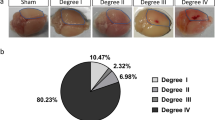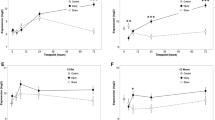Abstract
Unveiling the mechanisms participating in the damage and repair of traumatic brain injury (TBI) is fundamental to develop new therapies. The P2Y-like GPR17 receptor has recently emerged as a sensor of damage and a key actor in lesion remodeling/repair in the rodent brain, but its role in humans is totally unknown. Here, we characterized GPR17 expression in brain specimens from seven intensive care unit TBI patients undergoing neurosurgery for contusion removal and from 28 autoptic TBI cases (and 10 control subjects of matched age and gender) of two university hospitals. In both neurosurgery and autoptic samples, GPR17 expression was strong inside the contused core and progressively declined distally according to a spatio-temporal gradient. Inside and around the core, GPR17 labeled dying neurons, reactive astrocytes, and activated microglia/macrophages. In peri-contused parenchyma, GPR17 decorated oligodendrocyte precursor cells (OPCs) some of which had proliferated, indicating re-myelination attempts. In autoptic cases, GPR17 expression positively correlated with death for intracranial complications and negatively correlated with patients’ post-traumatic survival. Data indicate lesion-specific sequential involvement of GPR17 in the (a) death of irreversibly damaged neurons, (b) activation of microglia/macrophages remodeling the lesion, and (c) activation/proliferation of multipotent parenchymal progenitors (both reactive astrocytes and OPCs) starting repair processes. Data validate GPR17 as a target for neurorepair and are particularly relevant to setting up new therapies for TBI patients.








Similar content being viewed by others
References
Lo EH (2008) A new penumbra: transitioning from injury into repair after stroke. Nature medicine 14(5):497–500
De Biase LM, Nishiyama A, Bergles DE (2010) Excitability and synaptic communication within the oligodendrocyte lineage. J Neurosci Off J Soc Neurosci 30(10):3600–3611
Fumagalli M, Lecca D, Abbracchio MP (2011) Role of purinergic signalling in neuro-immune cells and adult neural progenitors. Front Biosci 16:2326–2341
Simon C, Gotz M, Dimou L (2011) Progenitors in the adult cerebral cortex: cell cycle properties and regulation by physiological stimuli and injury. Glia 59(6):869–881
Buffo A, Vosko MR, Erturk D, Hamann GF, Jucker M, Rowitch D, Gotz M (2005) Expression pattern of the transcription factor Olig2 in response to brain injuries: implications for neuronal repair. Proc Natl Acad Sci U S A 102(50):18183–18188
Buffo A, Rite I, Tripathi P, Lepier A, Colak D, Horn AP, Mori T, Gotz M (2008) Origin and progeny of reactive gliosis: a source of multipotent cells in the injured brain. Proc Natl Acad Sci U S A 105(9):3581–3586
Berninger B, Costa MR, Koch U, Schroeder T, Sutor B, Grothe B, Gotz M (2007) Functional properties of neurons derived from in vitro reprogrammed postnatal astroglia. J Neurosci Off J Soc Neurosci 27(32):8654–8664
Heinrich C, Gascon S, Masserdotti G, Lepier A, Sanchez R, Simon-Ebert T, Schroeder T, Gotz M, Berninger B (2011) Generation of subtype-specific neurons from postnatal astroglia of the mouse cerebral cortex. Nat Protoc 6(2):214–228
Richardson WD, Young KM, Tripathi RB, McKenzie I (2011) NG2-glia as multipotent neural stem cells: fact or fantasy? Neuron 70(4):661–673
Kondo T, Raff M (2000) Oligodendrocyte precursor cells reprogrammed to become multipotential CNS stem cells. Science 289(5485):1754–1757
Marchetti B, Abbracchio MP (2005) To be or not to be (inflamed)—is that the question in anti-inflammatory drug therapy of neurodegenerative disorders? Trends Pharmacol Sci 26(10):517–525
Lecca D, Trincavelli ML, Gelosa P, Sironi L, Ciana P, Fumagalli M, Villa G, Verderio C, Grumelli C, Guerrini U, Tremoli E, Rosa P, Cuboni S, Martini C, Buffo A, Cimino M, Abbracchio MP (2008) The recently identified P2Y-like receptor GPR17 is a sensor of brain damage and a new target for brain repair. PLoS One 3(10):e3579
Pugliese AM, Trincavelli ML, Lecca D, Coppi E, Fumagalli M, Ferrario S, Failli P, Daniele S, Martini C, Pedata F, Abbracchio MP (2009) Functional characterization of two isoforms of the P2Y-like receptor GPR17: [35S]GTPgammaS binding and electrophysiological studies in 1321N1 cells. Am J Physiol Cell Physiol 297(4):C1028–1040
Ciana P, Fumagalli M, Trincavelli ML, Verderio C, Rosa P, Lecca D, Ferrario S, Parravicini C, Capra V, Gelosa P, Guerrini U, Belcredito S, Cimino M, Sironi L, Tremoli E, Rovati GE, Martini C, Abbracchio MP (2006) The orphan receptor GPR17 identified as a new dual uracil nucleotides/cysteinyl-leukotrienes receptor. EMBO J 25(19):4615–4627
Daniele S, Lecca D, Trincavelli ML, Ciampi O, Abbracchio MP, Martini C (2010) Regulation of PC12 cell survival and differentiation by the new P2Y-like receptor GPR17. Cell Signal 22(4):697–706
Daniele S, Trincavelli ML, Gabelloni P, Lecca D, Rosa P, Abbracchio MP, Martini C (2011) Agonist-induced desensitization/resensitization of human G protein-coupled receptor 17: a functional cross-talk between purinergic and cysteinyl-leukotriene ligands. J Pharmacol Exp Ther 338(2):559–567
Benned-Jensen T, Rosenkilde MM (2010) Distinct expression and ligand-binding profiles of two constitutively active GPR17 splice variants. Br J Pharmacol 159(5):1092–1105
Buccioni M, Marucci G, Dal Ben D, Giacobbe D, Lambertucci C, Soverchia L, Thomas A, Volpini R, Cristalli G (2011) Innovative functional cAMP assay for studying G protein-coupled receptors: application to the pharmacological characterization of GPR17. Purinergic Signal 7(4):463–468
Maekawa A, Balestrieri B, Austen KF, Kanaoka Y (2009) GPR17 is a negative regulator of the cysteinyl leukotriene 1 receptor response to leukotriene D4. Proc Natl Acad Sci U S A 106(28):11685–11690
Wunder F, Tinel H, Kast R, Geerts A, Becker EM, Kolkhof P, Hutter J, Erguden J, Harter M (2010) Pharmacological characterization of the first potent and selective antagonist at the cysteinyl leukotriene 2 (CysLT(2)) receptor. Br J Pharmacol 160(2):399–409
Back M, Dahlen SE, Drazen JM, Evans JF, Serhan CN, Shimizu T, Yokomizo T, Rovati GE (2011) International Union of Basic and Clinical Pharmacology. LXXXIV: leukotriene receptor nomenclature, distribution, and pathophysiological functions. Pharmacol Rev 63(3):539–584
Eberini I, Daniele S, Parravicini C, Sensi C, Trincavelli ML, Martini C, Abbracchio MP (2011) In silico identification of new ligands for GPR17: a promising therapeutic target for neurodegenerative diseases. J Comput Aided Mol Des 25(8):743–752
Fumagalli M, Daniele S, Lecca D, Lee PR, Parravicini C, Fields RD, Rosa P, Antonucci F, Verderio C, Trincavelli ML, Bramanti P, Martini C, Abbracchio MP (2011) Phenotypic changes, signaling pathway, and functional correlates of GPR17-expressing neural precursor cells during oligodendrocyte differentiation. J Biol Chem 286(12):10593–10604
Boda E, Vigano F, Rosa P, Fumagalli M, Labat-Gest V, Tempia F, Abbracchio MP, Dimou L, Buffo A (2011) The GPR17 receptor in NG2 expressing cells: focus on in vivo cell maturation and participation in acute trauma and chronic damage. Glia 59(12):1958–1973
Ceruti S, Villa G, Genovese T, Mazzon E, Longhi R, Rosa P, Bramanti P, Cuzzocrea S, Abbracchio MP (2009) The P2Y-like receptor GPR17 as a sensor of damage and a new potential target in spinal cord injury. Brain 132(Pt 8):2206–2218
Yu GL, Wei EQ, Zhang SH, Xu HM, Chu LS, Zhang WP, Zhang Q, Chen Z, Mei RH, Zhao MH (2005) Montelukast, a cysteinyl leukotriene receptor-1 antagonist, dose- and time-dependently protects against focal cerebral ischemia in mice. Pharmacology 73(1):31–40
Zanier ER, Ortolano F, Ghisoni L, Colombo A, Losappio S, Stocchetti N (2007) Intracranial pressure monitoring in intensive care: clinical advantages of a computerized system over manual recording. Crit Care 11(1):R7
Boda E, Buffo A (2010) Glial cells in non-germinal territories: insights into their stem/progenitor properties in the intact and injured nervous tissue. Arch Ital Biol 148(2):119–136
Raff MC (1989) Glial cell diversification in the rat optic nerve. Science 243(4897):1450–1455
Lecca D, Ceruti S (2008) Uracil nucleotides: from metabolic intermediates to neuroprotection and neuroinflammation. Biochem Pharmacol 75(10):1869–1881
Acknowledgments
The authors thank Prof. Enzo Wanke, University of Bicocca-Milan and Dr. Annalisa Buffo, University of Turin for useful discussion. The authors are also grateful to Prof. J. Dreßler and Benjamin Ondruschka (Institute for Legal Medicine, Medical Faculty University of Leipzig) for providing autoptic samples, to Dr. Mauro Pluderi, MD, and Dr. Marco Locatelli, MD, from the Department of Neurosurgery of the Ospedale Maggiore Policlinico di Milano for assistance in resection of contusions and collection of neurosurgical brain samples, and to Mrs. Katrin Becker (RBI of Pharmacology and Toxicology, Leipzig) for expert technical assistance. This work was partially supported by the Italian PRIN-COFIN (Project Prot. 2006059022 and 2008XFMEA3 to M.P.A) and by Deutsche Forschungsgemeinschaft (FR 1253/3-2); C.P. was supported by a Fondazione Cariplo fellowship (project number 2008.2907); M.F. is supported by a fellowship from Fondazione Italiana Sclerosi Multipla (grant N. 2010/R/2); C.H. was supported by a funding from the German Federal Ministry of Education and Research (BMBF, PtJ-Bio, 0313909), the European Fund for Regional Development (EFRE), and the Free State of Saxony (grant no. SAB12525).
Conflict of interest
None declared.
Author information
Authors and Affiliations
Corresponding author
Additional information
Heike Franke, Chiara Parravicini, and Davide Lecca have contributed equally to this study.
Rights and permissions
About this article
Cite this article
Franke, H., Parravicini, C., Lecca, D. et al. Changes of the GPR17 receptor, a new target for neurorepair, in neurons and glial cells in patients with traumatic brain injury. Purinergic Signalling 9, 451–462 (2013). https://doi.org/10.1007/s11302-013-9366-3
Received:
Accepted:
Published:
Issue Date:
DOI: https://doi.org/10.1007/s11302-013-9366-3




